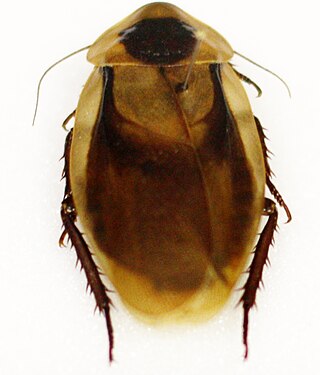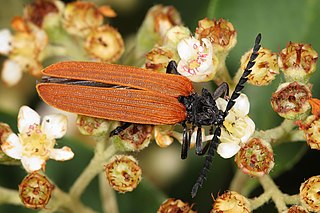
The Elateroidea are a large superfamily of beetles. It contains the familiar click beetles, fireflies, and soldier beetles and their relatives. It consists of about 25,000 species.

Blaberus discoidalis, commonly known as the discoid cockroach, tropical cockroach, West Indian leaf cockroach, false death's head cockroach, Haitian cockroach, and drummer, is a cockroach native to Central America of the "giant cockroach" family, Blaberidae.

The Encyclopedia of Life (EOL) is a free, online encyclopedia intended to document all of the 1.9 million living species known to science. It aggregates content to form "page"s for every known species. Content is compiled from existing trusted databases which are curated by experts and it calls on the assistance of non-experts throughout the world. It includes video, sound, images, graphics, information on characteristics, as well as text. In addition, the Encyclopedia incorporates species-related content from the Biodiversity Heritage Library, which digitizes millions of pages of printed literature from the world's major natural history libraries. The BHL digital content is indexed with the names of organisms using taxonomic indexing software developed by the Global Names project. The EOL project was initially backed by a US$50 million funding commitment, led by the MacArthur Foundation and the Sloan Foundation, who provided US$20 million and US$5 million, respectively. The additional US$25 million came from five cornerstone institutions—the Field Museum, Harvard University, the Marine Biological Laboratory, the Missouri Botanical Garden, and the Smithsonian Institution. The project was initially led by Jim Edwards and the development team by David Patterson. Today, participating institutions and individual donors continue to support EOL through financial contributions.

The Lycidae are a family in the beetle order Coleoptera, members of which are commonly called net-winged beetles. These beetles are cosmopolitan, being found in Nearctic, Palearctic, Neotropical, Afrotropical, Oriental, and Australian ecoregions.
Oreobates discoidalis, also known as the Tucuman robber frog, is a species of frog in the family Strabomantidae. It is found on the eastern flanks of the Andes in northern Argentina and Bolivia. Its natural habitat is subtropical or tropical moist montane forest. It is threatened by habitat loss.

Acanthoplus discoidalis is a species in the Hetrodinae, a subfamily of the katydid family (Tettigoniidae). Like its closest relatives, Acanthoplus discoidalis variously bears common names such as armoured katydid, armoured ground cricket, armoured bush cricket, corn cricket, setotojane and koringkriek. The species is native to parts of Angola, Namibia, Botswana, Zimbabwe and South Africa.

Alecton discoidalis is a species of firefly in the beetle family Lampyridae, commonly known as the Cuban endemic firefly. The larvae of this species are predators on both pulmonate and operculate land snails. Alecton discoidalis is the type species of the genus Alecton.

Prorella discoidalis is a moth in the family Geometridae first described by John Arthur Grossbeck in 1908. It is found in the US states of Arizona, New Mexico and Utah.
Secusio discoidalis is a moth in the subfamily Arctiinae. It was described by George Talbot in 1929. It is found in Angola, the Democratic Republic of the Congo, Somalia and South Africa. The species host plants have yet to be discovered.

Chromacilla discoidalis is a species of beetle in the family Cerambycidae.

Erebia discoidalis, the red-disked alpine, is a member of the subfamily Satyrinae of family Nymphalidae. It is found in North America from eastern Quebec, through northern Ontario, and the northern Prairies to northern British Columbia, the Northwest Territories, Yukon, and Alaska. It reaches just into the northern U.S. between Michigan and Montana, and also occurs in Asia, where it has been recorded from the Chukot Peninsula to the eastern Sayan Mountains and Amur. The habitat consists of large, open, grassy bogs and other areas with acidic soils.
Oberea discoidalis is a species of beetle in the family Cerambycidae. It was described by Karl Jordan in 1894. It is known from the Republic of the Congo, Gabon, Cameroon, the Ivory Coast, and Sierra Leone. It contains the variety Oberea discoidalis var. occidentalis.
Lucaina marginata is a species of net-winged beetle in the family Lycidae. It is found in North America.
Lucaina is a genus of net-winged beetles in the family Lycidae. There are at least 2 described species in Lucaina.

Calochrominae is a subfamily of net-winged beetles in the family Lycidae. There are at least 4 genera and more than 30 described species in Calochrominae.

Chorisoneura is a genus of cockroach in the family Ectobiidae. There are at least 90 described species in Chorisoneura.
Saprinus discoidalis is a species of clown beetle in the family Histeridae. It is found in North America.
Euphorbia discoidalis, commonly known as summer spurge, is a flowering plant. A dicot, it grows across parts of the southern United States. It reaches about 18 inches (460 mm) in height and has white flowers in the late summer and early fall. It is part of the Euphorbiaceae (spurge) family and the genus Euphorbia.










